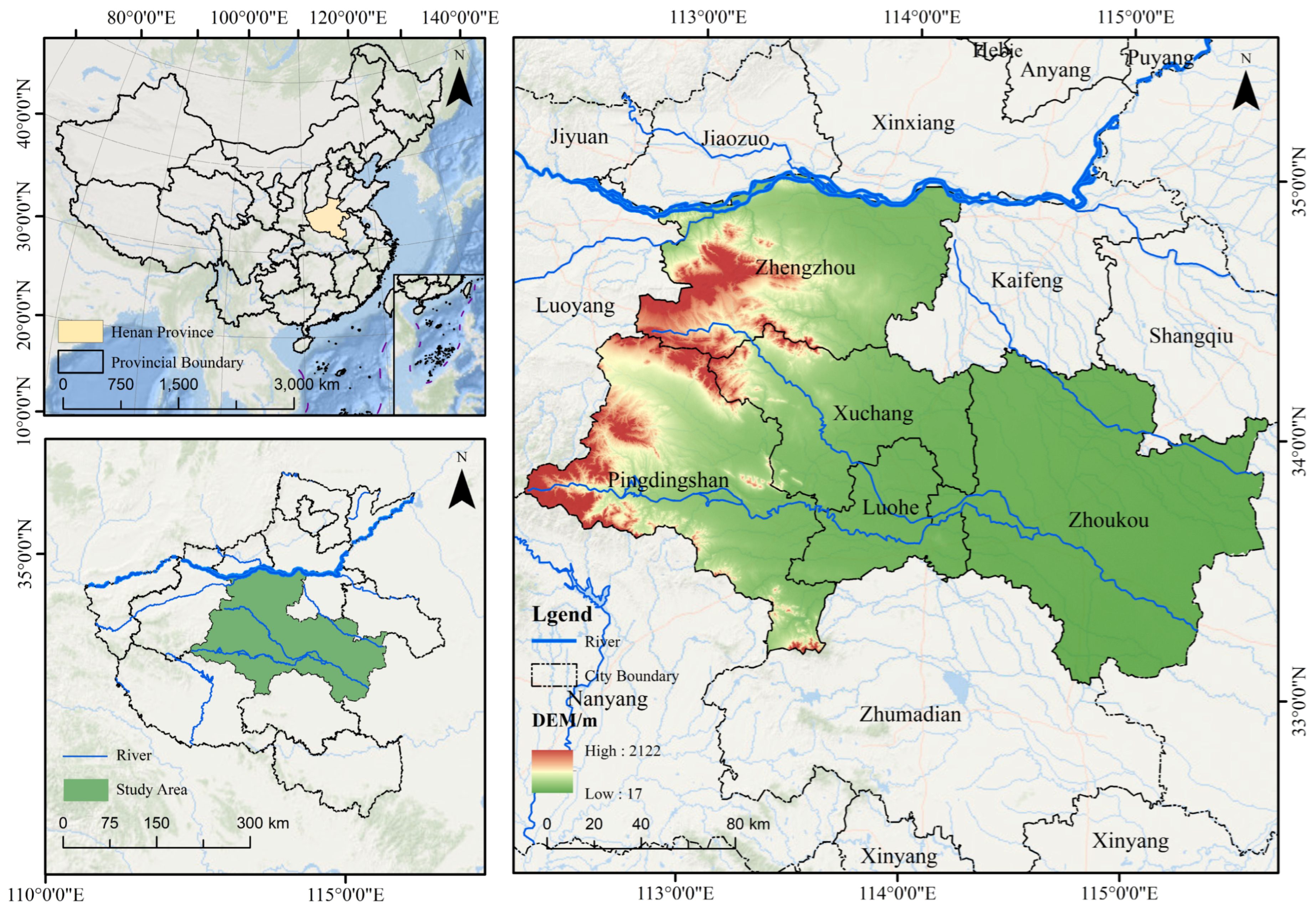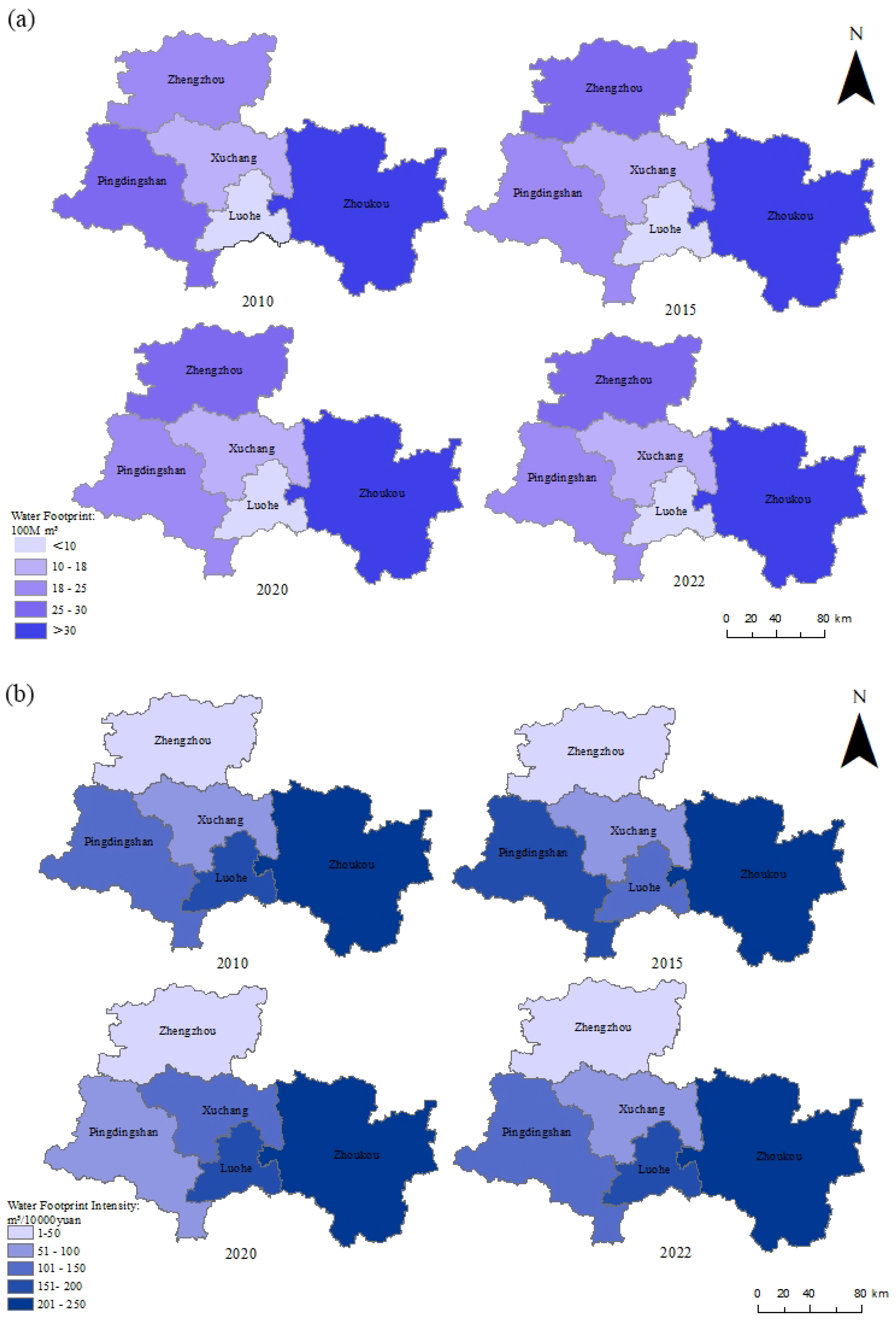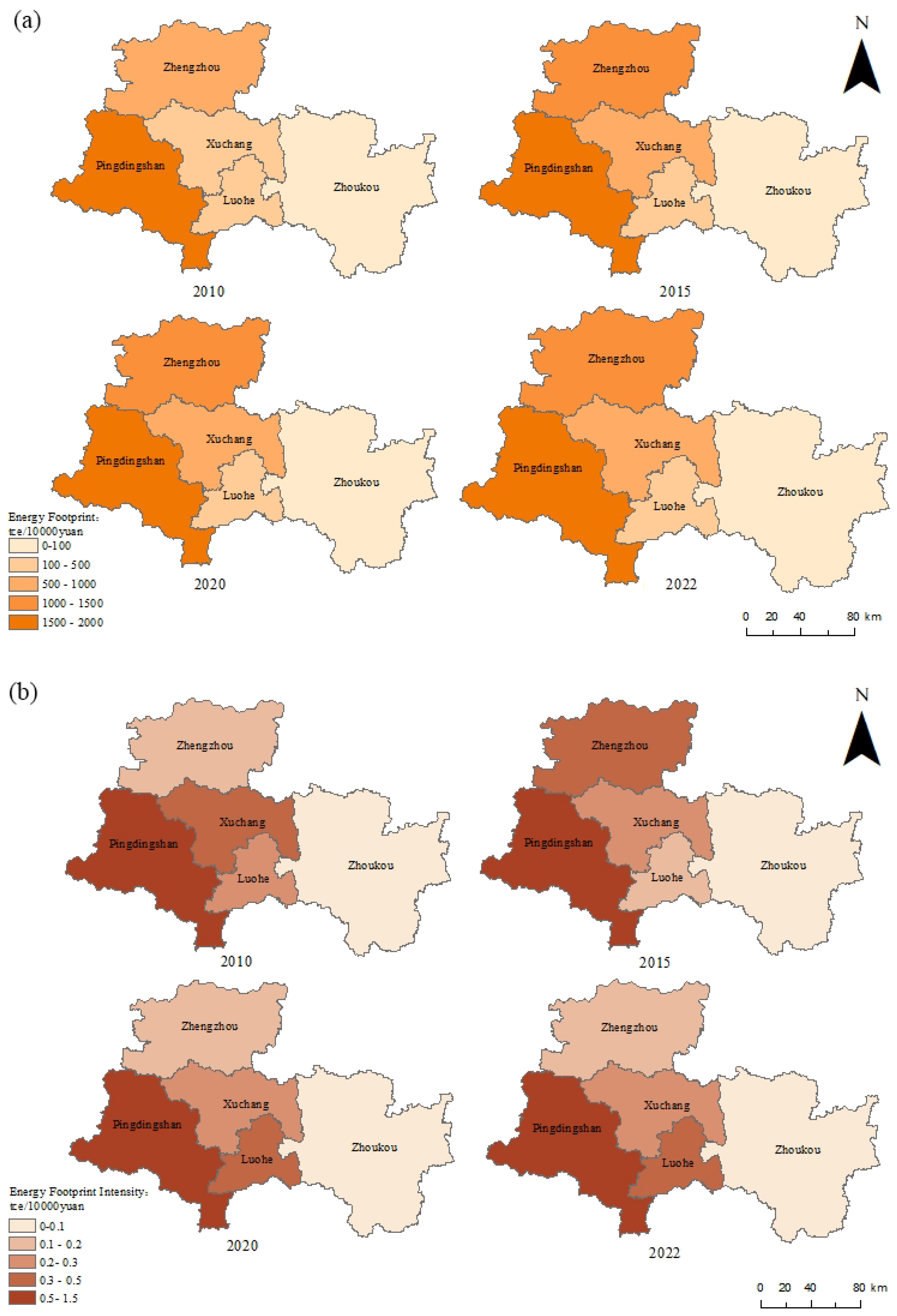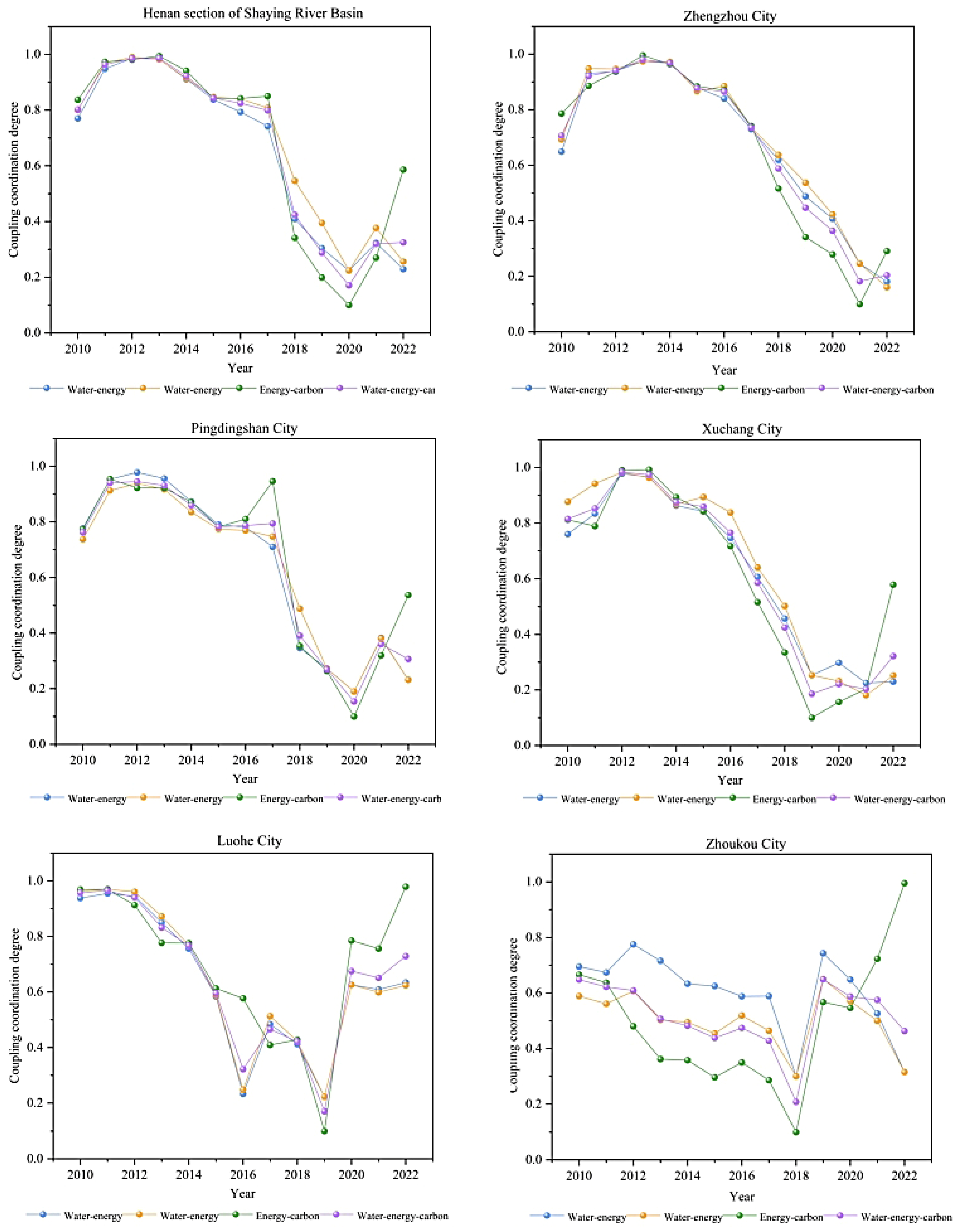Research on the Water–Energy–Carbon Coupling Changes and Their Influencing Factors in the Henan Section of the Sha Ying River Basin, China
Abstract
1. Introduction
2. Materials and Methods
2.1. Study Area
2.2. Data Sources
2.3. Research Methods
2.3.1. Water Footprint Accounting
2.3.2. Energy Footprint Accounting
2.3.3. Carbon Footprint Accounting
- (1)
- Carbon Emissions
- (2)
- Carbon Footprint
2.3.4. Coupling Coordination Degree Model
2.3.5. Relational Model
- (1)
- Selection of Influencing Factors
- (2)
- Construction of the Grey Relational Model
3. Results
3.1. Spatiotemporal Evolution Characteristics of “Water–Energy–Carbon”
3.1.1. Spatiotemporal Evolution Characteristics of Water Footprint
3.1.2. Spatiotemporal Evolution Characteristics of Energy Footprint
3.1.3. Spatiotemporal Evolution Characteristics of Carbon Footprint
3.2. Analysis of the “Water–Energy–Carbon” Coupling Coordination Relationship
3.3. Grey Association Analysis of the Influencing Factors of Water–Energy–Carbon Coupling Coordination Degree
4. Discussion
5. Conclusions
- (1)
- The evolution of water–energy–carbon footprints: From 2010 to 2022, the WF of the urban agglomeration in the Henan section of the Shaying River Basin exhibited an initial increase, followed by a subsequent decline. Concurrently, the energy footprint and carbon footprint demonstrated an aggregate upward trajectory, with significant differences and fluctuations in the change trends. Zhoukou City had a relatively high WF, Pingdingshan City generated high EC and CE, while Zhengzhou City’s carbon footprint first rose and then fell. Energy footprints and carbon footprints were positively correlated.
- (2)
- Changes in coupling coordination degree: From 2010 to 2022, the WEC of CCD the urban agglomeration presented an “increase-decrease-increase” trend. CCD change curves of each city were the same but showed significant spatial heterogeneity. The majority of cities demonstrated an ascending trend in the CCD from 2010 to 2015, but all produced varying degrees of decline and then rebounded from 2015 to 2022. Zhengzhou City and Pingdingshan City each showed an overall downward trend, with the lowest CCD among water, energy, and carbon in the urban agglomeration happening in 2020, featuring “severe imbalance”.
- (3)
- Key influencing factors: Water use per 10,000 CNY of GDP is the key influencing factor, followed by the agricultural structure and the year-end resident population. The urban agglomeration’s cities show significant spatial heterogeneity. Zhengzhou, Pingdingshan, Xuchang, and Luohe have the highest correlation between water use per 10,000 CNY of GDP and the water, energy, and carbon coupling coordination degree, while Zhoukou City has the highest correlation with the agricultural structure.
- (1)
- Classification of emission reduction and green transformation: In response to the differential WEC footprints and environmental pressures, strict restrictions will be imposed on the entry of high-energy-consumption projects in high-value cities for energy and carbon emissions (such as Pingdingshan), while promoting the clean transformation of traditional industries; to address the significant water consumption issue in Zhoukou, water-saving irrigation and breeding technologies will be promoted. Additionally, the government will establish special funds to support cities like Zhengzhou in developing a new energy and digital economy, driving regional economic transformation towards a low-carbon model.
- (2)
- Collaborative governance and ecological interaction: In response to the imbalance in CCD, a basin-wide WEC Collaborative Management Committee will be established to uniformly manage and control the total amounts of WEC emissions, with a focus on supervising cities where coordination is deteriorating. By establishing a cross-regional ecological compensation mechanism, fiscal transfer payments will promote cooperative efforts among cities in the fields of energy conservation and emission reduction, as well as water resource protection.
- (3)
- Precise policies and dynamic regulation: Based on the spatial heterogeneity of key influencing factors, there should be a promotion of industrial water-saving transformations in industrial cities (Zhengzhou, Pingdingshan) and implement water consumption quota management; in the agricultural city of Zhoukou, adjust the planting structure and develop water-saving agriculture. At the same time, one should establish a dynamic monitoring platform for core indicators to evaluate policy effects in real time and optimize governance strategies promptly.
Supplementary Materials
Author Contributions
Funding
Institutional Review Board Statement
Data Availability Statement
Conflicts of Interest
References
- Abdul, W.; Sher, K.; Martin, H.; Marian, S. The impact of hydro-biofuel-wind-solar energy consumption and coal consumption on carbon emission in G20 countries. Environ. Sci. Pollut. Res. Int. 2023, 30, 72503–72513. [Google Scholar]
- Cheng, Y.; Liu, H.M.; Wang, S.B. Global Action on SDGs: Policy Review and Outlook in a Post-pandemic Era. Sustainability 2021, 13, 6461. [Google Scholar] [CrossRef]
- Suggestions from the Henan Provincial Committee of the Communist Party of China on Formulating the 14th Five-Year Plan for National Economic and Social Development of Henan Province and the Long-Term Goals for 2035. Henan Daily, 8 January 2021.
- Zhang, L.; Wang, H.R.; Liu, X.; Li, Y.Y.; Jiang, X. An integrated analysis framework towards identifying circulation relationship of water-energy-carbon in complex system: A case study in Shandong Province. Ecol. Indic. 2024, 158, 111493. [Google Scholar] [CrossRef]
- Ni, X.J.; Huang, X.F.; Guo, R.; Wang, J.H.; Peng, K.M.; Zhang, W. Water–energy–carbon synergies and trade-offs: A daily nexus analysis for wastewater treatment plants. Resources. Conserv. Recycl. 2023, 188, 106712. [Google Scholar] [CrossRef]
- Zhang, Y.; Fang, J.; Wang, S. Energy-water nexus in electricity trade network: A case study of interprovincial electricity trade in China. Appl. Energy 2020, 257, 113685. [Google Scholar] [CrossRef]
- Wang, X.; Zhang, Q.; Xu, L. Water-energy-carbon nexus assessment of China’s iron and steel industry: Case study from plant level. J. Clean. Prod. 2020, 253, 119910. [Google Scholar] [CrossRef]
- Maziotis, A.; Garrido, S.R.; Arce, M.M. Understanding water-energy-carbon nexus in English and Welsh water industry by assessing eco-productivity of water companies. Npj Clean Water 2024, 7, 121. [Google Scholar] [CrossRef]
- Wang, X.; Klemeš, J.J.; Long, X. Measuring the environmental performance of the EU27 from the Water-Energy-Carbon nexus perspective. J. Clean. Prod. 2020, 265, 121832. [Google Scholar] [CrossRef]
- Tian, P.P.; Lu, H.W.; Heijungs, R.; Li, D.; Zhang, K.L.; Yang, Y.Y. Water-energy-carbon nexus in China’s intra and inter-regional trade. Sci. Total Environ. 2022, 806, 150666. [Google Scholar] [CrossRef]
- Zhang, D.; Jing, M.; Chang, B. Coordination Analysis and Driving Factors of “Water-Land-Energy-Carbon” Coupling in Nine Provinces of the Yellow River Basin. Water 2025, 17, 1138. [Google Scholar] [CrossRef]
- Yan, X.; Chen, J. Analysis of carbon emissions from social water cycle in the Pearl River Delta of COVID-19: Perspectives from water-energy-carbon nexus. J. Clean. Prod. 2024, 448, 141175. [Google Scholar] [CrossRef]
- Feng, M.Y.; Zhao, R.Q.; Huang, H.P.; Xiao, L.G.; Xie, Z.X. Water–energy–carbon nexus of different land use types: The case of Zhengzhou, China. Ecol. Indic. 2022, 141, 109073. [Google Scholar] [CrossRef]
- Wang, X.C.; Klemeš, J.J.; Wang, Y. Water-Energy-Carbon Emissions nexus analysis of China: An environmental input-output model-based approach. Appl. Energy 2020, 261, 114431. [Google Scholar] [CrossRef]
- Ma, X.T.; Zhang, T.Z.; Shen, X.Q.; Zhai, Y.J.; Hong, J.L. Environmental footprint assessment of China’s ceramic tile production from energy-carbon-water nexus insight. J. Clean. Prod. 2022, 337, 130606. [Google Scholar] [CrossRef]
- Wang, P.; Huang, R.; Zhang, S.F.; Liu, X.L. Pathways of carbon emissions reduction under the water-energy constraint: A case study of Beijing in China. Energy Policy 2023, 173, 113343. [Google Scholar] [CrossRef]
- Chhipi-Shrestha, G.; Hewage, K.; Sadiq, R. Water–energy–carbon nexus modeling for urban water systems: System dynamics approach. J. Water Resour. Plan. Manag. 2017, 143, 04017016. [Google Scholar] [CrossRef]
- Zhang, Y.; Fu, Z.H.; Xie, Y.L.; Li, Z.; Liu, Y.X.; Zhang, B.C.; Guo, H.C. Dynamic metabolism network simulation for energy-water nexus analysis: A case study of Liaoning Province, China. Sci. Total Environ. 2021, 779, 146440. [Google Scholar] [CrossRef]
- Xiang, W.q.; Yang, X.H.; Bian, D.H.; Pan, Z.S.; Chen, H.; Chen, Y.J.; Li, M.S. Evaluation and prediction of water-energy-carbon nexus efficiency in China based on a new multiregional input-output perspective. J. Environ. Manag. 2023, 339, 117786. [Google Scholar] [CrossRef]
- Liu, Y.T.; Chen, B. Water-energy scarcity nexus risk in the national trade system based on multiregional input-output and network environ analyses. Appl. Energy 2020, 268, 114974. [Google Scholar] [CrossRef]
- Wang, F.; Cao, Y.Q.; Chen, M.; Yang, Y.F. Network characteristics of the Water-Soil-Energy-Carbon association system in Nine Provinces/Regions of the Yellow River Basin. Adv. Sci. Technol. Water Resour. Hydropower 2024, 44, 31–37. [Google Scholar]
- Venkatesh, G.; Chan, A.; Brattebø, H. Understanding the water-energy-carbon nexus in urban water utilities: Comparison of four city case studies and the relevant influencing factors. Energy 2014, 75, 153–166. [Google Scholar] [CrossRef]
- He, Z.G. The Water–Energy–Carbon Coupling Coordination Level in China. Sustainability 2023, 16, 383. [Google Scholar] [CrossRef]
- Li, K.X.; Chao, Y.Q.; Fan, S.B. Simulation of “water-energy-carbon” system in three northeastern provinces based on system dynamics model. J. Ecol. 2023, 43, 6999–7011. [Google Scholar]
- Jonathan, C.; Al-Masri, R.A. The impact of adopting a water-energy nexus approach in Jordan on transboundary management. Environ. Sci. Policy 2021, 118, 49–55. [Google Scholar]
- Li, J.J. Spatialized carbon-energy-water footprint of emerging coal chemical industry in China. Renew. Sustain. Energy Rev. 2024, 189, 113919. [Google Scholar] [CrossRef]
- Wang, Y.F.; Han, Z.; Deng, X.Z. Water-Energy-Carbon Nexus Within the Urban Eco-Transformation of the Beijing-Tianjin-Hebei Region. Expert Syst. 2025, 42, e70015. [Google Scholar] [CrossRef]
- Gao, L.L.; Wu, Y.; Li, L.; Sun, C.; Li, D.H.; Liu, X.K. A Risk Assessment Method for Phosphorus Loss in Intensive Agricultural Areas—A Case Study in Henan Province, China. Agriculture 2024, 14, 1681. [Google Scholar] [CrossRef]
- Wang, S.X.; Wang, X.; Zhang, Z.C.; Wen, Q. Spatial and temporal distribution pattern of water yield in Henan section of Shaying River Basin and future multi-scenario modelling. Environ. Sci. Technol. 2024, 47, 47–56. [Google Scholar]
- Zhang, L.P. China City Statistical Yearbook 2023; China Statistics Press: Beijing, China, 2023; pp. 4–5. [Google Scholar]
- Hu, H.Z. China Energy Statistical Yearbook 2023; China Statistical Publishing House: Beijing, China, 2023; pp. 4–5. [Google Scholar]
- Li, Y.W.; Wu, X.W. Henan Statistical Yearbook 2023; China Statistics Press: Beijing, China, 2023; pp. 5–6. [Google Scholar]
- Hogeboom, R.J. The water footprint concept and water’s grand environmental challenges. One Earth 2020, 2, 218–222. [Google Scholar] [CrossRef]
- Hoekstra, Y.A. Water footprint assessment: Evolvement of a new research field. Water Resour. Manag. 2017, 31, 3061–3081. [Google Scholar] [CrossRef]
- Bunsen, J.; Berger, M.; Finkbeiner, M. Planetary boundaries for water–A review. Ecol. Indic. 2021, 121, 107022. [Google Scholar] [CrossRef]
- Lucas, P.L.; Wilting, H.C.; Hof, A.F. Allocating planetary boundaries to large economies: Distributional consequences of alternative perspectives on distributive fairness. Glob. Environ. Change 2020, 60, 102017. [Google Scholar] [CrossRef]
- Steffen, W.; Richardson, K.; Rockström, J. Planetary boundaries: Guiding human development on a changing planet. Science 2015, 347, 1259855. [Google Scholar] [CrossRef]
- Fang, K.; Shen, W.B.; Dong, D.M. Improvement and prediction of energy footprint accounting—A case study of Jilin province. Geogr. Res. 2011, 30, 1835–1846. [Google Scholar]
- Venetoulis, J.; Talberth, J. Refining the ecological footprint. In Sustainable Development; CRC Press: Boca Raton, FL, USA, 2008; Volume 10, pp. 441–469. [Google Scholar]
- Zhu, X.M.; Wang, Z.S. Research on the spatial correlation pattern of carbon footprint breadth and influencing factors in China. Res. World 2021, 05, 38–48. [Google Scholar]
- Yan, J.J.; Deng, N.; Chen, B.; Zhang, X.W. Study on carbon footprint change and its influencing factors in the Beijing-Tianjin-Hebei region under the “dual-carbon” target. J. Ecol. 2025, 45, 1275–1288. [Google Scholar]
- Zhang, N.; Yang, X.; Chen, T. Spatial and temporal characteristics of coupled water-energy-food system coordination in western China. China Environ. Sci. 2022, 42, 4444–4456. [Google Scholar]
- Li, W.J.; Wang, Y.; Xie, S.Y.; Cheng, X. Coupling coordination analysis and spatiotemporal heterogeneity between urbanization and ecosystem health in Chongqing municipality, China. Sci. Total Environ. 2021, 791, 148311. [Google Scholar] [CrossRef] [PubMed]
- Guo, X.Y.; Mu, X.Q.; Ding, Z.S.; Qin, D.L. Nonlinear effects and driving mechanisms of multidimensional urbanisation on PM2.5 concentration in the Yangtze River Delta. J. Geogr. 2021, 76, 1274–1293. [Google Scholar]
- Liu, S.C.; Ye, Y.M.; Zhong, S.Q. Research on the Relationship between Urban Construction Land Expansion and the Migration and Decoupling of Economic Growth Centers in China. Resour. Environ. Yangtze River Basin 2020, 29, 2563–2571. [Google Scholar]
- Li, Z.J.; Xu, J.L.; Wang, J. Study on the spatio-temporal heterogeneity of urban carbon emissions and its influencing factors in the Yangtze River Economic Belt. Resour. Environ. Yangtze Basin 2023, 32, 525–536. [Google Scholar]
- Liu, Y.F.; Yuan, Z.H.; Guo, L.X. Analysis of spatial and temporal evolution characteristics and influencing factors of green growth level in Shaanxi Province cities. J. Nat. Resour. 2022, 37, 200–220. [Google Scholar]
- Liu, N.; Li, H.J.; Bian, Z.Q.; Liu, X.J. Analysis of factors affecting water footprint based on spatial panel STIRPAT model—A case study of Shandong Province. J. Ecol. 2022, 42, 9335–9347. [Google Scholar]
- Huang, X.H. Research on the Development Strategies of Agricultural Industry Clusters in Henan Province under Supply-side Structural Reform. Agric. Econ. 2022, 09, 24–25. [Google Scholar]
- Yang, X.; Li, D.H.; Wang, M. Coupling Coordination Degree of Land, Ecology, and Food and Its Influencing Factors in Henan Province. Agriculture 2024, 14, 1612. [Google Scholar] [CrossRef]
- Yang, Y.; Zhang, Y.Y. Changes in water-energy-carbon coupling and influencing factors in Hubao-Eyu resource-based urban agglomeration. China Environ. Sci. 2023, 43, 6212–6224. [Google Scholar]
- Cao, Y.Q.; Li, J.; Xie, L.F.; Yao, J.Q.; Li, K.X.; Zhang, N.Y. Coupling coordination of the water–energy–carbon system in three provinces of Northeastern China. Front. Environ. Sci. 2023, 11, 1261339. [Google Scholar] [CrossRef]
- Liu, J.H.; Pu, L.Y.; Huang, L.C.; Shi, T.L. Research on the Coupling Evaluation and Driving Factors of Water–Energy–Carbon in the Yellow River Basin. Water 2023, 15, 2377. [Google Scholar] [CrossRef]
- Liu, S.Y.; Kang, H. Research on Influencing Factors and Emission Reduction Path of Carbon Emission in Shanxi. Ind. Innov. Res. 2024, 21, 116–118. [Google Scholar]
- Zhang, R.H. A new model of high-quality development of fishing villages led by sea ranch in the context of rural revitalization—Taking Qingyuitan Village in Rongcheng City, Shandong Province as an example. Sichuan Agric. Sci. Technol. 2024, 12, 92–95. [Google Scholar]






| Level | Severe Imbalance | Moderate Imbalance | Basic Coordination | Good Coordination | High Coordination |
|---|---|---|---|---|---|
| Coupling Coordination Degree | (0, 0.2] | (0.2, 0.4] | (0.4, 0.6] | (0.6, 0.8] | (0.8, 1] |
| Indicator | Water–Energy (Y1) | Water–Carbon (Y2) | Energy–Carbon (Y3) | Water–Energy–Carbon (Y4) | Average |
|---|---|---|---|---|---|
| Year-end resident population (X1) | 0.58 | 0.60 | 0.62 | 0.62 | 0.61 |
| Urban population ratio (X2) | 0.56 | 0.57 | 0.59 | 0.59 | 0.58 |
| Employment ratio of secondary and tertiary industries (X3) | 0.56 | 0.58 | 0.59 | 0.60 | 0.58 |
| Regional per capita GDP (X4) | 0.50 | 0.51 | 0.53 | 0.53 | 0.51 |
| Total social fixed investment (X5) | 0.50 | 0.50 | 0.52 | 0.53 | 0.51 |
| Per capita road paving area (X6) | 0.54 | 0.55 | 0.57 | 0.57 | 0.56 |
| Built-up area as a proportion of total land area (X7) | 0.53 | 0.54 | 0.56 | 0.57 | 0.55 |
| Water consumption per 10,000 CNY GDP (X8) | 0.76 | 0.78 | 0.79 | 0.81 | 0.78 |
| Agricultural industry structure (X9) | 0.60 | 0.62 | 0.63 | 0.63 | 0.62 |
Disclaimer/Publisher’s Note: The statements, opinions and data contained in all publications are solely those of the individual author(s) and contributor(s) and not of MDPI and/or the editor(s). MDPI and/or the editor(s) disclaim responsibility for any injury to people or property resulting from any ideas, methods, instructions or products referred to in the content. |
© 2025 by the authors. Licensee MDPI, Basel, Switzerland. This article is an open access article distributed under the terms and conditions of the Creative Commons Attribution (CC BY) license (https://creativecommons.org/licenses/by/4.0/).
Share and Cite
Liu, X.; Wu, Y.; Li, L.; Sun, C.; Liu, J.; Wang, W. Research on the Water–Energy–Carbon Coupling Changes and Their Influencing Factors in the Henan Section of the Sha Ying River Basin, China. Agriculture 2025, 15, 1165. https://doi.org/10.3390/agriculture15111165
Liu X, Wu Y, Li L, Sun C, Liu J, Wang W. Research on the Water–Energy–Carbon Coupling Changes and Their Influencing Factors in the Henan Section of the Sha Ying River Basin, China. Agriculture. 2025; 15(11):1165. https://doi.org/10.3390/agriculture15111165
Chicago/Turabian StyleLiu, Xueke, Yong Wu, Ling Li, Chi Sun, Jianwei Liu, and Wenzhen Wang. 2025. "Research on the Water–Energy–Carbon Coupling Changes and Their Influencing Factors in the Henan Section of the Sha Ying River Basin, China" Agriculture 15, no. 11: 1165. https://doi.org/10.3390/agriculture15111165
APA StyleLiu, X., Wu, Y., Li, L., Sun, C., Liu, J., & Wang, W. (2025). Research on the Water–Energy–Carbon Coupling Changes and Their Influencing Factors in the Henan Section of the Sha Ying River Basin, China. Agriculture, 15(11), 1165. https://doi.org/10.3390/agriculture15111165






